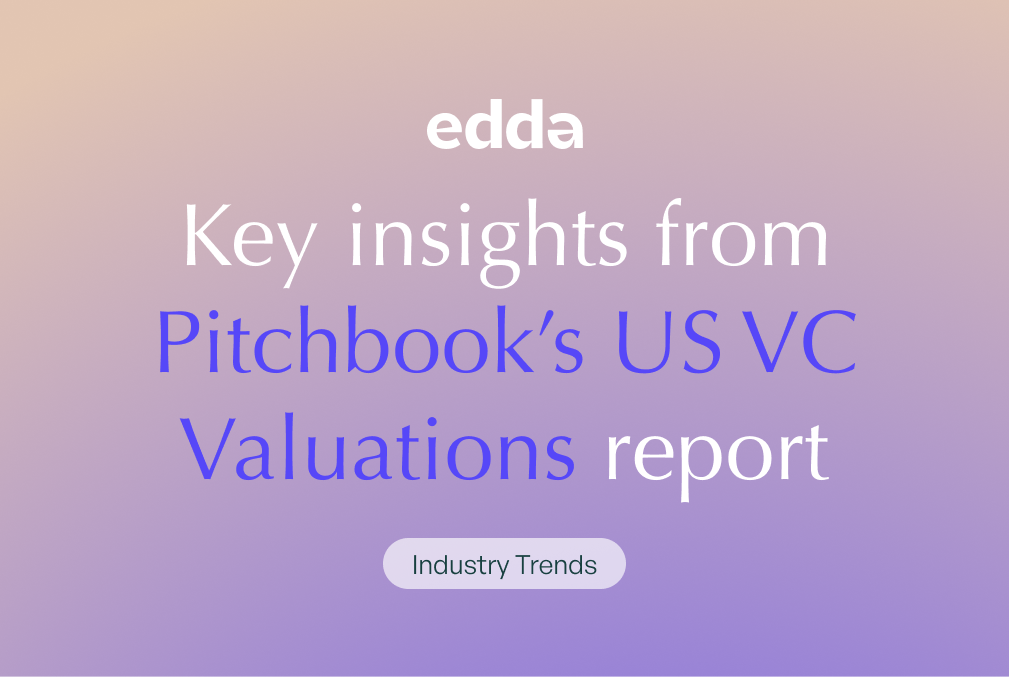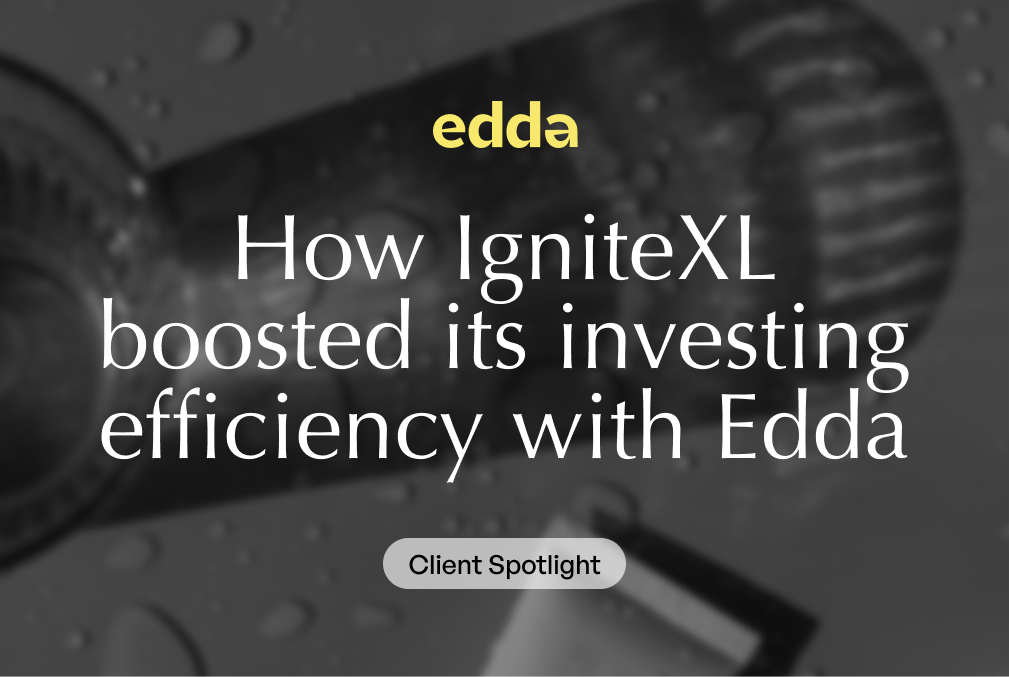PitchBook’s Q2 2024 US VC Valuations Report offers a clear look at the shifting dynamics in the current venture capital market. As AI and market corrections shape the landscape, strategic investments and selective funding are becoming the norm. For venture capitalists, understanding these trends is essential for making informed decisions.
This article breaks down the report’s key insights, providing a deeper understanding of where the market is heading. Whether you’re managing deal flow or navigating complex exit strategies, staying informed on these trends will help you position your firm for success.
In addition, learn how Edda’s HERA.I AI-powered venture capital management software simplifies deal flow, portfolio management, and investor relations, giving you the tools to navigate market changes and maintain your competitive edge.
Market Overview
Who is dominating the venture capital landscape in Q2 2024?
AI and ML are the clear frontrunners in Q2 2024, accounting for nearly half of the deal value. Major deals, such as CoreWeave’s $8.6 billion and xAI’s $6 billion, have played a big role in these impressive numbers. The surge in interest is fueled by rapid advancements in technology and a strategic shift by many companies to incorporate AI into their operations, riding the wave of growing market momentum.
How are valuations adjusting in the current venture capital market?
Valuations are still high in sectors like AI, but the overall market is going through a correction. While median valuations might look strong, they don’t necessarily signal a market recovery. Instead, they reflect a cautious atmosphere where fewer companies are securing new funding rounds. Many are turning to debt or convertible notes instead of raising equity at lower valuations.
What impact are macroeconomic factors having on the venture capital market?
High interest rates and inflation continue to weigh heavily on venture markets. While there’s increasing speculation that interest rate cuts could be on the horizon, the overall optimism is still much lower than it was a year ago.
The public markets, especially the tech-focused S&P 500, are showing a split performance—big companies are pulling ahead, but the rest of the market is lagging. This divide is affecting late-stage and growth-stage ventures, where liquidity challenges remain a major issue.
How is public market performance influencing venture capital?
The public market’s performance has been a bit uneven, with the top seven companies in the S&P 500 seeing strong gains, while the rest of the index lags behind. This gap is also evident in newly listed tech companies, which have faced challenges after their IPOs. Their valuations haven’t grown as expected, largely due to the high cost of capital.
What trends are emerging in startup financing during Q2 2024?
The gap between financing rounds has grown noticeably, especially for later-stage companies. For instance, Series D+ rounds are now happening more than two years apart, compared to just 1.2 years in 2021.
This delay suggests that companies are postponing new rounds as long as they can, often because their earlier valuations were set during a time of higher market multiples, which are tough to achieve in today’s environment.
What is the current sentiment in the venture capital market?
The market shows mixed feelings—AI and ML are drawing significant interest and investment, yet overall, the venture landscape remains cautious. Investors are getting more selective, zeroing in on companies with solid fundamentals and strong growth potential. This has created a situation where high median valuations exist alongside a tough fundraising environment, especially for companies outside the AI and ML sectors.
Valuations
What drives the persistence of high median valuations in a cautious market?
High median valuations in Q2 2024 are mostly due to specific financial factors, not a broad market recovery. These numbers are heavily influenced by a few big deals in high-growth sectors like AI and ML, where companies can command premium prices because of their potential for strong returns. The high valuations also reflect the quality of companies that are able to secure funding in a very selective investment climate.
How do alternative financing methods impact venture capital valuations?
In tough market conditions, many startups are opting for alternative financing methods like convertible notes or debt instead of raising equity at lower valuations. This strategy helps them avoid diluting their equity under unfavorable terms while still getting the capital they need.
As a result, fewer priced rounds are taking place, and the median valuation data is now more influenced by these fewer, but higher-quality, equity raises.
What effect does the extended time between financing rounds have on valuations?
The longer gaps between financing rounds are having a big impact on market valuations. Companies are raising new rounds after extended intervals, often with valuations that were set during better market conditions. This means that when these companies finally do come to market, they bring higher valuations from previous rounds, pushing up the median figures even though the overall market remains cautious.
How do revenue multiples and growth rates influence current valuations?
Valuations are now more closely linked to specific financial metrics like revenue multiples and growth rates. Companies that show strong revenue growth and maintain high multiples are more likely to attract investment at higher valuations.
This has resulted in a scenario where, even with fewer deals, median valuations stay high, reflecting the tougher benchmarks companies need to meet to secure funding in today’s market.
What role do selective investments play in shaping valuation trends?
The trend of selective investments is key to shaping current valuation trends. Investors are zeroing in on companies with the strongest financials and growth potential, which often results in higher valuations for those that meet these standards. This selectivity means that while overall deal activity might be lower, the companies that do secure funding are getting it at higher valuations, pushing up the median figures.
Investor Trends
How are CVC firms adapting their investment strategies in 2024?
CVC firms are becoming more strategic with their investments, targeting early-stage companies that offer non-cash benefits like access to advanced technology or synergies with their existing operations. This strategic focus is impacting their venture capital deal flow, as they now prioritize quality over quantity in their investment choices.
In areas like AI, where infrastructure and resources are critical, CVCs are backing startups that closely align with their corporate goals. This approach keeps them at the cutting edge of innovation and allows them to use their resources to gain a competitive edge. The high valuations seen in CVC-backed deals highlight the strategic value of these investments, beyond just the financial returns.
What specific challenges are nontraditional investors facing in the current market?
Nontraditional investors like asset managers and private equity firms are struggling to justify high valuations in a market where capital is more expensive and returns are uncertain. To address these challenges, private equity due diligence has become increasingly critical.
These investors, who once provided significant funding for late-stage companies, are now concentrating on fewer, higher-quality deals. Their pullback has created a gap, especially for companies that depended on them to stay private longer. This shift is pushing startups to either accept lower valuations or seek alternative financing options, like secondary sales or convertible notes.
Why is there a growing valuation spread in rounds involving different types of investors?
The gap in valuations is growing between rounds that include strategic investors like CVCs and those that don’t. CVCs, focused on long-term strategic benefits, are willing to pay more for companies that align with their goals, which drives up valuations in these rounds.
On the other hand, rounds without these investors tend to have lower valuations, as they rely more on traditional financial metrics. This difference underscores the growing importance of strategic alignment in today’s venture capital market, where financial returns aren’t the only factor driving investment decisions.
How are crossover investors influencing the late-stage market?
Crossover investors, who work in both public and private markets, are focusing their money on the biggest and most promising private companies. This selective strategy has resulted in larger deals and higher valuations for those that meet their strict standards.
However, this approach also means that many other late-stage companies are finding it hard to raise capital because they can’t hit the high benchmarks these investors set. As a result, the market is becoming divided, with only the strongest companies able to secure funding on favorable terms.
What role does strategic investment play in the current venture capital environment?
Strategic investment is gaining importance as investors seek more than just financial returns. CVCs and other strategic investors are prioritizing companies that offer long-term benefits, like technological innovations or opportunities for market expansion.
This shift is driving up valuations for startups that align with these goals, and non-cash returns are becoming a bigger factor in investment decisions. The focus on strategic value is changing the venture capital landscape, with investors aiming to build long-term partnerships rather than just filling their financial portfolios.
Liquidity Events
What specific trends are emerging in M&A as a preferred exit strategy?
M&A is becoming the preferred exit strategy for venture-backed companies, especially those that can’t afford to wait for the IPO market to bounce back. However, the nature of these deals highlights some key trends.
Many of the M&A transactions in 2024 are small and often kept under wraps, suggesting they’re more about rescuing companies that might otherwise struggle. Big, high-profile acquisitions are rare, mostly limited to specific sectors like healthcare. This pattern indicates that M&A is more of a backup plan rather than a strong source of returns for investors.
How are liquidation preferences and complex deal terms affecting the outcomes of exits?
As companies stay private longer and keep raising capital, the payout structures for investors have become more complicated. Liquidation preferences, which ensure preferred shareholders get paid before common ones, are now playing a bigger role in exit scenarios.
In today’s market, these preferences can significantly cut down what founders and common shareholders receive, especially if the exit valuation doesn’t meet the high expectations from earlier funding rounds.
Additionally, cumulative dividends and other protective terms have become more common, making the exit process even more complex and potentially reducing overall returns for common shareholders.
Why are secondary markets becoming crucial in the current liquidity landscape?
With the IPO market stuck and M&A deals often falling short of expectations, secondary markets have become essential for giving early investors and employees a way to cash out. These markets let stakeholders sell their shares without needing the company to go public or be acquired, offering a crucial option in a slow exit environment.
However, not all secondary transactions are the same—top-performing companies can keep high valuations, while others might face significant discounts. The fact that these discounts are narrowing shows growing demand, but it also underscores the pressure on less successful companies to find liquidity solutions.
How is the extended timeline before seeking exits reshaping company strategies?
The longer gaps between financing rounds and exits are changing how companies manage their operations and finances. Startups are now more focused on hitting milestones that will help maintain their valuations over extended periods, which often means carefully managing resources and planning for a longer runway.
This delay in seeking liquidity also makes companies more dependent on additional funding or secondary sales to keep things running. The trend of staying private longer is having a big impact on how companies are valued and how investors plan their exit strategies.
What impact do current M&A and liquidation trends have on the broader venture capital ecosystem?
Trends in M&A and liquidation preferences are creating ripples throughout the venture capital world. Investors are getting more cautious, aware that returns from exits might be lower than expected because of complicated deal terms and a tough market.
This caution is driving more conservative investment strategies, with a focus on making sure portfolio companies are ready for a successful M&A exit or a delayed IPO. Strategic alignment and careful management of liquidation preferences are now crucial in how deals are structured and how exits are planned.
Challenges
How are deal negotiations evolving in 2024, and what new terms are emerging?
Deal negotiations in 2024 are getting more complicated, with the balance of power increasingly tipping in favor of investors. Along with traditional protections like liquidation preferences and cumulative dividends, we’re seeing the rise of newer or less common terms as investors look to minimize risk.
These include tougher anti-dilution provisions and enhanced voting rights that give investors more control over important company decisions. This shift highlights the increased caution in the market, where investors want more guarantees before they commit their capital.
What are the recent trends in anti-dilution provisions, and how are they impacting startups?
Anti-dilution provisions, designed to protect investors from future rounds of financing at lower valuations, are becoming tougher. Full ratchet anti-dilution clauses, which were rare in better market conditions, are now making a comeback.
These clauses can heavily dilute the equity of founders and early employees if a down round happens. The return of these aggressive terms highlights the market’s current focus on safeguarding investor value, even if it comes at the cost of a startup’s long-term equity structure.
How are enhanced voting rights shifting the balance of power in venture deals?
Enhanced voting rights are becoming more common in term sheets, giving investors more control over key company decisions, like when to exit or raise additional funds. These rights can include veto power on major decisions, the ability to appoint board members, or the need for investor approval on strategic moves.
This move toward greater investor control shows a market where investors are more cautious and want more influence in the companies they support, especially in today’s uncertain economic climate.
What role do pay-to-play provisions have in today’s venture capital deals?
Pay-to-play provisions, which require existing investors to join future funding rounds or lose certain privileges like preferred status, are becoming more common in 2024. These provisions help ensure that investors continue to support the company, even during tough times.
While they can protect a startup by securing ongoing funding, they also put pressure on investors to commit more capital or face penalties, which can create complicated dynamics in future funding rounds.
How are liquidation preferences being structured differently in the current market?
Liquidation preferences aren’t new, but the way they’re being structured is changing. Investors are now often negotiating for multiple times their invested capital back before common shareholders see any returns—like 2x or 3x liquidation preferences.
This aggressive approach is especially common in late-stage deals where the risk is perceived to be higher. These terms can pose serious challenges for founders, particularly in exit scenarios where the company doesn’t hit a high valuation, leaving common shareholders with minimal returns.
Master the VC Landscape with Edda’s Cutting-Edge Software
The Q2 2024 US VC Valuations Report highlights the increasing complexity and competitiveness within the venture capital ecosystem, where strategic investments and efficient deal management are essential for success.
As the market becomes more selective and valuations are driven by specific financial metrics and strategic alignment, the need for dynamic venture capital management software has never been greater.
That’s where Edda’s venture capital software comes in.
Edda offers a HERA.I AI-powered platform combines deal flow management and a venture capital CRM to centralize everything you need—from finding and managing deals to tracking your portfolio and staying connected with investors. This dealflow CRM makes your day-to-day operations smoother and helps you make smarter, data-driven decisions.
If you’re trying to take advantage of the trends identified in the report, Edda’s venture capital portfolio management software is a real game-changer. It’s designed to help you manage your deal flow efficiently, so you can spot and act on the best opportunities.
Whether you’re dealing with complicated exit strategies, managing big deals, or trying to get the most out of your portfolio, Edda’s HERA.I software gives you the tools you need to succeed. By bringing Edda into your strategy, you’ll be better prepared to handle the challenges of today’s venture capital world and make the most of new opportunities as they arise.
Try Edda today and stay ahead in a competitive market!









